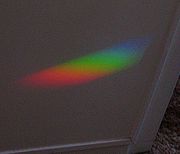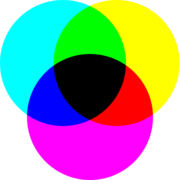
Color mixing
Encyclopedia

Primary Colors
Primary Colors: A Novel of Politics is a roman à clef, a work of fiction that purports to describe real life characters and events — namely, Bill Clinton's first presidential campaign in 1992...
, three secondary colors (colors made from 2 of the three primary colors in equal amounts), and one tertiary color made from all three primary colors.

Additive Mixing
Additive mixing of colors generally involves mixing colors of light. In additive mixing of colors there are three primary colors: redRed
Red is any of a number of similar colors evoked by light consisting predominantly of the longest wavelengths of light discernible by the human eye, in the wavelength range of roughly 630–740 nm. Longer wavelengths than this are called infrared , and cannot be seen by the naked eye...
, green
Green
Green is a color, the perception of which is evoked by light having a spectrum dominated by energy with a wavelength of roughly 520–570 nanometres. In the subtractive color system, it is not a primary color, but is created out of a mixture of yellow and blue, or yellow and cyan; it is considered...
, and blue
Blue
Blue is a colour, the perception of which is evoked by light having a spectrum dominated by energy with a wavelength of roughly 440–490 nm. It is considered one of the additive primary colours. On the HSV Colour Wheel, the complement of blue is yellow; that is, a colour corresponding to an equal...
. In the absence of color or, when no colors are showing, the result is black. If all three primary colors are showing, the result is white. When red and green combine, the result is yellow. When red and blue combine, the result is magenta. Additive mixing is used in television and computer monitors to produce a wide range of colors using only three primary colors.

Subtractive Mixing
Subtractive mixing is done by selectively removing certain colors, for instance with optical filtersFilter (optics)
Optical filters are devices which selectively transmit light of different wavelengths, usually implemented as plane glass or plastic devices in the optical path which are either dyed in the mass or have interference coatings....
. The three primary colors in subtractive mixing are yellow
Yellow
Yellow is the color evoked by light that stimulates both the L and M cone cells of the retina about equally, with no significant stimulation of the S cone cells. Light with a wavelength of 570–590 nm is yellow, as is light with a suitable mixture of red and green...
, magenta
Magenta
Magenta is a color evoked by light stronger in blue and red wavelengths than in yellowish-green wavelengths . In light experiments, magenta can be produced by removing the lime-green wavelengths from white light...
, and cyan
Cyan
Cyan from , transliterated: kýanos, meaning "dark blue substance") may be used as the name of any of a number of colors in the blue/green range of the spectrum. In reference to the visible spectrum cyan is used to refer to the color obtained by mixing equal amounts of green and blue light or the...
. In subtractive mixing of color, the absence of color is white and the presence of all three primary colors is black. In subtractive mixing of colors, the secondary colors are the same as the primary colors from additive mixing, and vice versa. Subtractive mixing is used to create a variety of colors when printing
Printing
Printing is a process for reproducing text and image, typically with ink on paper using a printing press. It is often carried out as a large-scale industrial process, and is an essential part of publishing and transaction printing....
on paper by combining a small number of ink
Ink
Ink is a liquid or paste that contains pigments and/or dyes and is used to color a surface to produce an image, text, or design. Ink is used for drawing and/or writing with a pen, brush, or quill...
colors, and also when painting. The mixing of pigment
Pigment
A pigment is a material that changes the color of reflected or transmitted light as the result of wavelength-selective absorption. This physical process differs from fluorescence, phosphorescence, and other forms of luminescence, in which a material emits light.Many materials selectively absorb...
s does not produce perfect subtractive color mixing because some light from the subtracted color is still being reflected. This results in a darker and desaturated color compared to the color that would be achieved with ideal filters.
Importance to vision
Additive color mixing—red and green combining to make yellow, for example, or blue and yellow producing white—runs counter to the commonsense observation that, for example, yellow paint plus cyan paint makes green paint. In this case, one must understand that the wavelengths of light that reach the eye are often selected via these more intuitive subtractive processes: for example, cyan paint appears to our eye as cyan because it absorbs red wavelengths, and a yellow paint appears yellow because it absorbs blue wavelengths. When white light falls on a combination of cyan and yellow, then, both red and blue are absorbed, and green is reflected to the eye.External links
- Interactive Java applet on the additive mixing of RGB colors by Wolfgang Bauer
- Interactive Java applet on the subtractive mixing of CYM colors by Wolfgang Bauer

